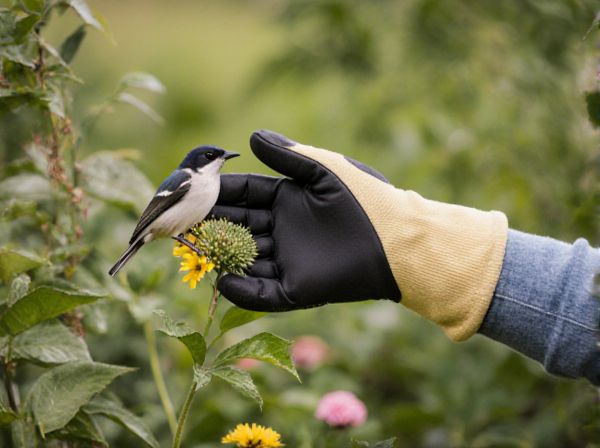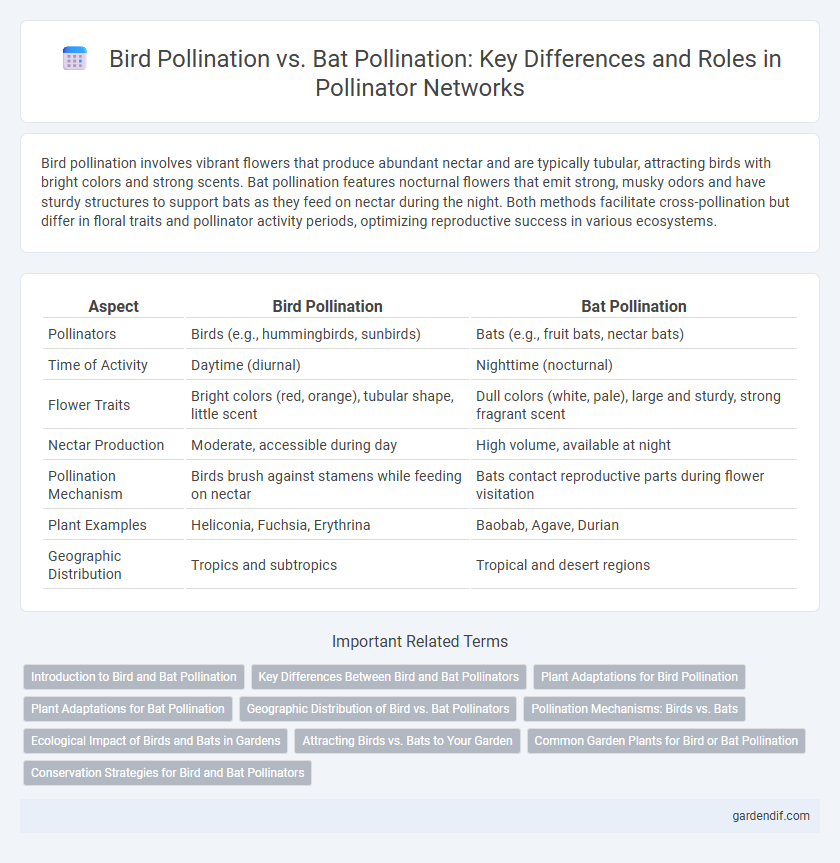
Bird pollination vs Bat pollination Illustration
Bird pollination involves vibrant flowers that produce abundant nectar and are typically tubular, attracting birds with bright colors and strong scents. Bat pollination features nocturnal flowers that emit strong, musky odors and have sturdy structures to support bats as they feed on nectar during the night. Both methods facilitate cross-pollination but differ in floral traits and pollinator activity periods, optimizing reproductive success in various ecosystems.
Table of Comparison
| Aspect | Bird Pollination | Bat Pollination |
|---|---|---|
| Pollinators | Birds (e.g., hummingbirds, sunbirds) | Bats (e.g., fruit bats, nectar bats) |
| Time of Activity | Daytime (diurnal) | Nighttime (nocturnal) |
| Flower Traits | Bright colors (red, orange), tubular shape, little scent | Dull colors (white, pale), large and sturdy, strong fragrant scent |
| Nectar Production | Moderate, accessible during day | High volume, available at night |
| Pollination Mechanism | Birds brush against stamens while feeding on nectar | Bats contact reproductive parts during flower visitation |
| Plant Examples | Heliconia, Fuchsia, Erythrina | Baobab, Agave, Durian |
| Geographic Distribution | Tropics and subtropics | Tropical and desert regions |
Introduction to Bird and Bat Pollination
Bird pollination primarily involves nectar-feeding birds like hummingbirds, sunbirds, and honeyeaters, which transfer pollen while feeding, favoring brightly colored, tubular flowers with strong scents. Bat pollination, or chiropterophily, occurs mostly at night with fruit bats and nectar-feeding bats visiting large, pale or white flowers that emit strong, musky odors and produce abundant nectar. Both pollination types enhance plant reproduction in diverse ecosystems by promoting cross-pollination through specialized animal-plant interactions.
Key Differences Between Bird and Bat Pollinators
Bird pollination typically involves vibrant, diurnal flowers with ample nectar, designed to attract visually oriented pollinators like hummingbirds. Bat pollination occurs mainly at night with flowers emitting strong scents and producing copious nectar to lure echolocating or scent-driven bats. Key differences include the time of activity, sensory attraction methods, and flower morphology adapted to each pollinator's characteristics.
Plant Adaptations for Bird Pollination
Bird pollination, or ornithophily, drives plants to develop vivid red, orange, or yellow tubular flowers rich in nectar to attract birds such as hummingbirds, sunbirds, and honeyeaters. These plants often have sturdy structures and produce copious amounts of dilute nectar, facilitating effective bird feeding and pollen transfer. Unlike bat-pollinated flowers that rely on strong scents and nocturnal opening, bird-pollinated flowers typically lack strong odors and open during the day to coincide with bird activity patterns.
Plant Adaptations for Bat Pollination
Plants adapted for bat pollination often exhibit large, sturdy flowers with pale or white colors that are highly visible in low light conditions, enhancing attraction during nighttime activity. These flowers typically emit strong, musky or fruity scents that are easily detected by the echolocation and olfactory senses of bats. Nectar production is abundant and positioned deep within the flower to accommodate the feeding behavior of bats, ensuring effective pollen transfer during their nocturnal foraging.
Geographic Distribution of Bird vs. Bat Pollinators
Bird pollination primarily occurs in tropical and subtropical regions, with hummingbirds dominating the Americas and sunbirds prevalent in Africa and Asia. Bat pollination is widespread in tropical and desert areas of the Americas, Africa, Asia, and Australia, with nectar-feeding bats like glossophagine species playing a crucial role. Geographic distribution reflects adaptation to local climates and flora, influencing the specialization of bird and bat pollinators in their respective ecosystems.
Pollination Mechanisms: Birds vs. Bats
Bird pollination relies on visual cues such as bright colors and strong scents to attract avian species, which typically transfer pollen while feeding on nectar with their beaks. Bat pollination depends on nocturnal activity patterns and olfactory signals, as bats use echolocation and select flowers emitting strong, musky fragrances that accommodate their feeding style. The contrasting mechanisms highlight adaptations in flower morphology, with bird-pollinated flowers often being tubular and brightly colored, while bat-pollinated flowers tend to be large, pale, and open nocturnally to suit bat foraging behavior.
Ecological Impact of Birds and Bats in Gardens
Bird pollination enhances garden biodiversity by supporting a wide range of flowering plants that rely on visual cues such as bright colors and open shapes, promoting ecological balance and habitat connectivity. Bat pollination contributes to nocturnal ecosystem functions by enabling the reproduction of night-blooming plants and facilitating the growth of fruit species critical for wildlife nutrition. Both birds and bats provide essential pollination services that maintain plant diversity, improve garden productivity, and support overall ecosystem resilience.
Attracting Birds vs. Bats to Your Garden
Brightly colored, tubular flowers rich in nectar effectively attract bird pollinators such as hummingbirds, while pale, large, and fragrant night-blooming flowers draw bat pollinators by emitting strong scents. Bird-pollinated plants often produce less intense fragrances and thrive in daylight, whereas bat-pollinated plants rely on echolocation-friendly shapes and nighttime nectar production. Designing a garden with diverse flowering schedules and shapes maximizes pollination by catering to the sensory preferences and activity patterns of both birds and bats.
Common Garden Plants for Bird or Bat Pollination
Bird pollination, or ornithophily, typically favors common garden plants such as trumpet vines, salvias, and hibiscus, which exhibit brightly colored, tubular flowers rich in nectar to attract hummingbirds and sunbirds. Bat pollination, or chiropterophily, involves plants like agave, banana, and balsa tree, which often have large, pale, and fragrant flowers that open at night to accommodate nocturnal bats. Both pollination strategies are vital for biodiversity, enhancing fruit and seed production in home gardens and supporting ecological balance.
Conservation Strategies for Bird and Bat Pollinators
Conservation strategies for bird and bat pollinators emphasize habitat preservation and restoration to support their specialized foraging behaviors, with efforts targeting native flowering plant species that provide essential nectar resources. Protecting nocturnal environments by minimizing artificial lighting benefits bat pollinators by maintaining natural feeding patterns, while creating buffer zones around nesting and roosting sites safeguards bird pollinators from habitat fragmentation. Integrating community-based monitoring programs enhances data collection on pollinator populations, enabling adaptive management to mitigate threats such as pesticide exposure and climate change effects.
Bird pollination vs Bat pollination Infographic

 gardendif.com
gardendif.com